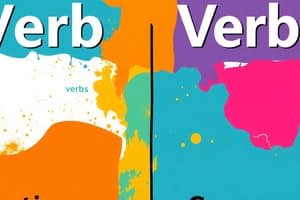Podcast
Questions and Answers
¿Qué tipo de verbos conectan el sujeto de una oración con el complemento?
¿Qué tipo de verbos conectan el sujeto de una oración con el complemento?
- Verbos de acción
- Verbos de enlace (correct)
- Verbos auxiliares
- Verbos de negación
¿Cuál de los siguientes verbos es un ejemplo de verbo de enlace?
¿Cuál de los siguientes verbos es un ejemplo de verbo de enlace?
- Reír
- Hacer
- Caminar
- Parecer (correct)
¿En qué consiste la negación de verbos para expresar lo opuesto a una acción?
¿En qué consiste la negación de verbos para expresar lo opuesto a una acción?
- Usar adverbios
- Conjugación en futuro
- Agregar sustantivos
- Utilizar verbos auxiliares (correct)
¿Cómo se forman las preguntas de verbos?
¿Cómo se forman las preguntas de verbos?
¿Qué son las frases verbales?
¿Qué son las frases verbales?
¿Cuál de las siguientes opciones define mejor un verbo de acción?
¿Cuál de las siguientes opciones define mejor un verbo de acción?
En la oración "Ella lee cada noche antes de ir a la cama", ¿cuál es el verbo de acción?
En la oración "Ella lee cada noche antes de ir a la cama", ¿cuál es el verbo de acción?
¿Cuál de los siguientes verbos es un verbo transitivo?
¿Cuál de los siguientes verbos es un verbo transitivo?
En la oración "El niño estudió para el examen", ¿cuál es el objeto del verbo transitivo "estudió"?
En la oración "El niño estudió para el examen", ¿cuál es el objeto del verbo transitivo "estudió"?
¿Cuál de los siguientes verbos es un verbo intransitivo?
¿Cuál de los siguientes verbos es un verbo intransitivo?
Flashcards are hidden until you start studying
Study Notes
Action Verbs Explained
Action verbs are the backbone of any sentence. They create motion, change, and convey meaning. Here's what you need to know about action verbs:
Definition
An action verb is a type of verb that indicates an action or an occurrence. These verbs show that something is happening, such as walking, talking, or reading. For example, "I walk," "He talks," and "She reads."
Example Sentences
Here are some examples of sentences using action verbs:
- Walking is one of my favorite forms of exercise.
- He talks too much about his accomplishments.
- She reads every night before going to bed.
Types of Action Verbs
There are three main types of action verbs: transitive, intransitive, and linking verbs:
Transitive Verbs
Transitive verbs require an object, often a noun, pronoun, or gerund (verb form of a noun) to complete their meaning. Examples of transitive verbs include eat, drink, study, and run. The subject of these verbs is typically the person or thing performing the action, while the object is the recipient or result of that action. For instance, "John ate an apple" and "The boy studied for the test."
Intransitive Verbs
Intransitive verbs do not take objects. These verbs can only have subjects, which indicate the person or thing performing the action without requiring an additional object. Some common intransitive verbs are laugh, sneeze, sleep, and walk. For example, "My sister laughed" and "The baby sneezed."
Linking Verbs
Linking verbs also known as copular verbs or linking verbs connect the subject of a sentence to the complement. These verbs do not show action but rather describe or identify the subject. Examples of linking verbs are be, become, seem, and appear. For example, "The dog is barking" and "The book seems interesting."
Verb Tenses
Action verbs also come in different tenses, which indicate the time when the action takes place. The most common tenses include the present simple, present continuous, past simple, past continuous, and present perfect.
Helping Verbs
Helping verbs, also known as auxiliary verbs, are used with other verbs to form various verb tenses, such as the present continuous, past simple, and present perfect tenses. Examples of helping verbs include do, have, and be. For example, "I am helping you," "John has been helping," and "She did not help."
Verb Negation
Verb negation is used to convey the opposite of an action. Verbs can be negated using not, never, and no. For example, "I don't walk," "He never talks," and "She no longer reads."
Verb Questions
Verb questions are formed by using an auxiliary verb in the correct tense and the main verb in its base form. For example, "Do you walk," "Did he talk," and "Does she read."
Verb Phrases
Verb phrases combine a main verb with one or more helping verbs, adverbs, or adverbial phrases. For example, "I have been helping," "John was talking loudly," and "She will be reading soon."
Verb Clauses
Verb clauses are groups of words containing a subject and a verb. They can be independent or dependent, and they can function as nouns, adjectives, or adverbs in a sentence. For example, "The fact that she is walking is true," "I knew that he was talking," and "He went to the store because he needed milk."
Conclusion
Action verbs play a crucial role in conveying meaning and creating sentences. By understanding the different types, tenses, and uses of action verbs, you can improve your writing and communication skills.
Studying That Suits You
Use AI to generate personalized quizzes and flashcards to suit your learning preferences.




